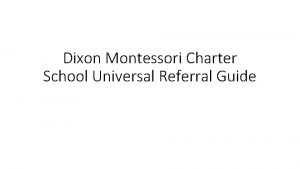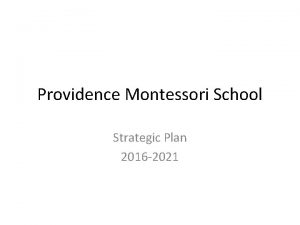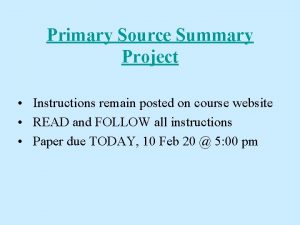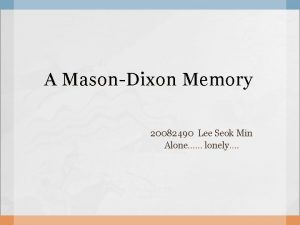Dixon Montessori Charter School Universal Referral Guide Who
















- Slides: 16

Dixon Montessori Charter School Universal Referral Guide

Who here understands the DMCS discipline policy? • Who has given a referral this year? • Who here should have given a referral, but did not?

Objectives • Explain the policy and logic for our discipline system • Define and categorize problem behaviors • Referral “How To” • Guidelines for responding to problem behavior • Kickboard data entry • Decision making process/follow through

PBIS Discipline System Goals • Increase consistency across the school. • Make school a predictable, consistent, positive environment for students. • Discipline always starts with teaching, prompting and acknowledging positive behavior • School-wide expectations and implications • Classroom expectations and implications • Individual student expectations and implications http: //dixonmontessorideanofstudents. weebly. com/disciplineat-dmcs. html


What happens when expectations are not met? • Delivering negative consequences for problem behavior is a necessary but insufficient strategy for reducing problem behavior. • Always define, teach and acknowledge expectations before you focus on negative consequences • Use negative consequences to achieve the following four functions: • • Prevent a problem behavior from being rewarded Prevent a problem behavior from escalating Prevent a problem behavior from interrupting instruction for others Provide a teaching opportunity (“this behavior is NOT being respectful”)

Consistency is Key • Students need to know how the adults at DMCS will react to their behavior. • Basic Structure • • Try again, re-direction, de-escalation Time out/break/removal from activity “White Slip” or detention and loss of Kickboard point Referral • Level three behaviors warrant an automatic referral

DMCS Behavior Flow Chart

Level 1 Consequences • “Try again” • Flip card to yellow • Give a negative on Kickboard • Speak with the teacher about reaching expectations • Write a White Slip

Level 2 Consequences • Write a Referral (an administrator will be there shortly) • Enter behavior on Kickboard • Give detention (MS) • Loss of Fun Friday or Lunch Recess (Elem)

Level 3 Consequence • Write a Referral and send the student to the office -Every student has the right to learn! Stay calm, remain firm, remove the student with the problem behavior and continue to teach. • Follow up with office recommendations

How to write a referral https: //dmcs. kickboardforschools. com/culture/daily-activity • Relevant information • • • Who (select name on app, do not write other student names) What (problem behavior, short and sweet) When (what time of day is recorded by Kickboard) Where (location)) Why (why does this keep happening) Details • ----------------- • Administrative Decision

Purposes of delivering a referral • Interrupt problem behavior • Prevent escalation • Teach discrimination about what is acceptable • “This is not being respectful” • Minimize likelihood that problem behavior will be rewarded. • Allow education to continue for others • Safety • Access to instruction

When do we use a referral? • Teachers have the authority to manage problem behavior in class (or with a partner) • Detention, Loss of Recess • Think-time • Time out (define Time out) • Use an office referral if a problem behavior (a) interferes with on-going education of others, (b) threatens safety, or (c) is of a severity requiring more extended intervention (e. g. more than 1 min). • Note that in-class interventions should also be included in the Kickboard data collection system… and are useful for decision-making

What to do after a referral • Once you enter a referral on Kickboard the office is automatically notified. • An administrator will determine a consequence • An administrator will follow through on the consequence and record decisions on Kickboard • The administrator will provide teacher feedback • The teacher will follow through with the recommended consequence

In-School Suspension Room • A student may be assigned In-School Suspension (ISS) • ISS ranges from one period to 5 days • If a student is assigned ISS, the teacher needs to provide work for the student. • Take concrete action to correct behavior in the future
 Dixon montessori charter school
Dixon montessori charter school Latin american montessori bilingual public charter school
Latin american montessori bilingual public charter school Maria montessori 1870-1952
Maria montessori 1870-1952 Charterbare
Charterbare Tattle tooth program
Tattle tooth program Tattletooth program
Tattletooth program Whats a referral in school
Whats a referral in school Maria montessori school rockford il
Maria montessori school rockford il Jesus my shepherd montessori school
Jesus my shepherd montessori school Belfair montessori magnet school
Belfair montessori magnet school Providence montessori school
Providence montessori school Blessed star montessori christian school
Blessed star montessori christian school Spreidingsbreedte
Spreidingsbreedte George washington dixon
George washington dixon Gda academy
Gda academy David dixon ubc
David dixon ubc A mason-dixon memory summary
A mason-dixon memory summary






























